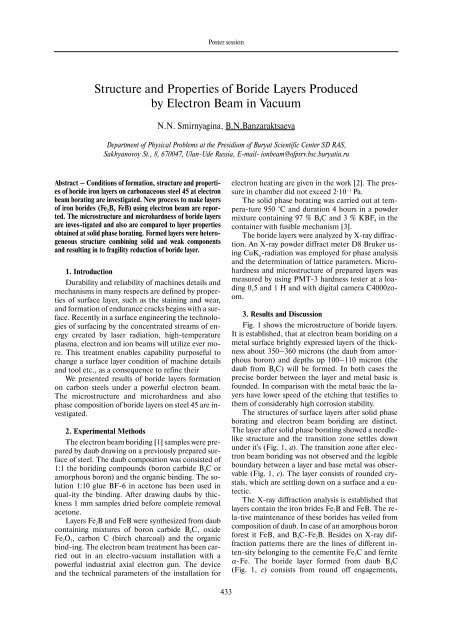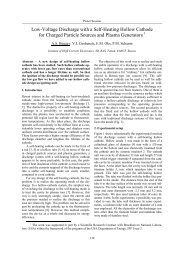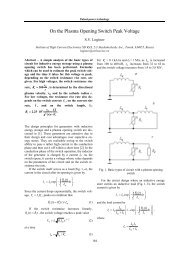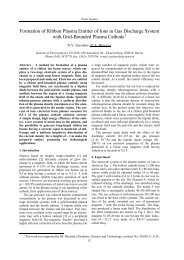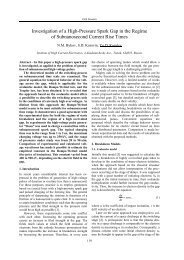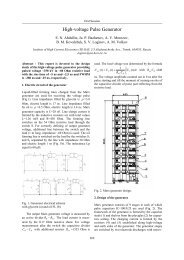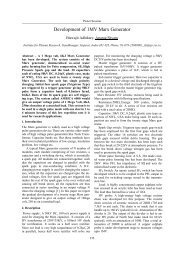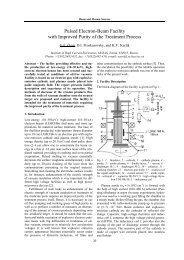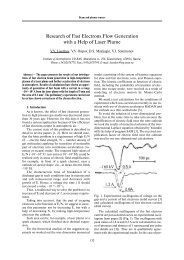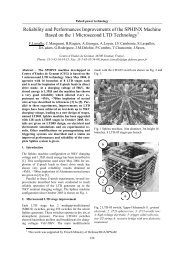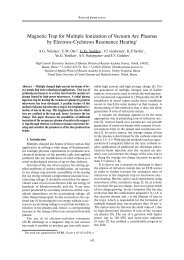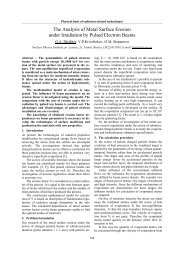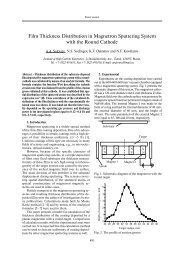structure and properties of boride layers produced by electron beam ...
structure and properties of boride layers produced by electron beam ...
structure and properties of boride layers produced by electron beam ...
Create successful ePaper yourself
Turn your PDF publications into a flip-book with our unique Google optimized e-Paper software.
Poster session<br />
Structure <strong>and</strong> Properties <strong>of</strong> Boride Layers Produced<br />
<strong>by</strong> Electron Beam in Vacuum<br />
N.N. Smirnyagina, B.N.Banzaraktsaeva<br />
Department <strong>of</strong> Physical Problems at the Presidium <strong>of</strong> Buryat Scientific Center SD RAS,<br />
Sakhyanovoy St., 8, 670047, Ulan-Ude Russia, E-mail- ion<strong>beam</strong>@<strong>of</strong>psrv.bsc.buryatia.ru<br />
Abstract – Conditions <strong>of</strong> formation, <strong>structure</strong> <strong>and</strong> <strong>properties</strong><br />
<strong>of</strong> <strong>boride</strong> iron <strong>layers</strong> on carbonaceous steel 45 at <strong>electron</strong><br />
<strong>beam</strong> borating are investigated. New process to make <strong>layers</strong><br />
<strong>of</strong> iron <strong>boride</strong>s (Fe 2 B, FeB) using <strong>electron</strong> <strong>beam</strong> are reported.<br />
The micro<strong>structure</strong> <strong>and</strong> microhardness <strong>of</strong> <strong>boride</strong> <strong>layers</strong><br />
are inves-tigated <strong>and</strong> also are compared to layer <strong>properties</strong><br />
obtained at solid phase borating. Formed <strong>layers</strong> were heterogeneous<br />
<strong>structure</strong> combining solid <strong>and</strong> weak components<br />
<strong>and</strong> resulting in to fragility reduction <strong>of</strong> <strong>boride</strong> layer.<br />
1. Introduction<br />
Durability <strong>and</strong> reliability <strong>of</strong> machines details <strong>and</strong><br />
mechanisms in many respects are defined <strong>by</strong> <strong>properties</strong><br />
<strong>of</strong> surface layer, such as the staining <strong>and</strong> wear,<br />
<strong>and</strong> formation <strong>of</strong> endurance cracks begins with a surface.<br />
Recently in a surface engineering the technologies<br />
<strong>of</strong> surfacing <strong>by</strong> the concentrated streams <strong>of</strong> energy<br />
created <strong>by</strong> laser radiation, high-temperature<br />
plasma, <strong>electron</strong> <strong>and</strong> ion <strong>beam</strong>s will utilize ever more.<br />
This treatment enables capability purposeful to<br />
change a surface layer condition <strong>of</strong> machine details<br />
<strong>and</strong> tool etc., as a consequence to refine their<br />
We presented results <strong>of</strong> <strong>boride</strong> <strong>layers</strong> formation<br />
on carbon steels under a powerful <strong>electron</strong> <strong>beam</strong>.<br />
The micro<strong>structure</strong> <strong>and</strong> microhardness <strong>and</strong> also<br />
phase composition <strong>of</strong> <strong>boride</strong> <strong>layers</strong> on steel 45 are investigated.<br />
2. Experimental Methods<br />
The <strong>electron</strong> <strong>beam</strong> boriding [1] samples were prepared<br />
<strong>by</strong> daub drawing on a previously prepared surface<br />
<strong>of</strong> steel. The daub composition was consisted <strong>of</strong><br />
1:1 the boriding compounds (boron carbide В 4 С or<br />
amorphous boron) <strong>and</strong> the organic binding. The solution<br />
1:10 glue BF-6 in аcetone has been used in<br />
qual-ity the binding. After drawing daubs <strong>by</strong> thickness<br />
1 mm samples dried before complete removal<br />
acetone.<br />
Layers Fe 2 B <strong>and</strong> FeB were synthesized from daub<br />
containing mixtures <strong>of</strong> boron carbide В 4 С, oxide<br />
Fe 2 O 3 , carbon C (birch charcoal) <strong>and</strong> the organic<br />
bind-ing. The <strong>electron</strong> <strong>beam</strong> treatment has been carried<br />
out in an electro-vacuum installation with a<br />
powerful industrial axial <strong>electron</strong> gun. The device<br />
<strong>and</strong> the technical parameters <strong>of</strong> the installation for<br />
<strong>electron</strong> heating are given in the work [2]. The pressure<br />
in chamber did not exceed 2 . 10 –3 Pa.<br />
The solid phase borating was carried out at tempera-ture<br />
950 °С <strong>and</strong> duration 4 hours in a powder<br />
mixture containing 97 % B 4 C <strong>and</strong> 3 % KBF 4 in the<br />
container with fusible mechanism [3].<br />
The <strong>boride</strong> <strong>layers</strong> were analyzed <strong>by</strong> X-ray diffraction.<br />
An X-ray powder diffract meter D8 Bruker using<br />
CuK α -radiation was employed for phase analysis<br />
<strong>and</strong> the determination <strong>of</strong> lattice parameters. Microhardness<br />
<strong>and</strong> micro<strong>structure</strong> <strong>of</strong> prepared <strong>layers</strong> was<br />
measured <strong>by</strong> using PMT-3 hardness tester at a loading<br />
0,5 <strong>and</strong> 1 H <strong>and</strong> with digital camera C4000zoom.<br />
3. Results <strong>and</strong> Discussion<br />
Fig. 1 shows the micro<strong>structure</strong> <strong>of</strong> <strong>boride</strong> <strong>layers</strong>.<br />
It is established, that at <strong>electron</strong> <strong>beam</strong> boriding on a<br />
metal surface brightly expressed <strong>layers</strong> <strong>of</strong> the thickness<br />
about 350–360 microns (the daub from amorphous<br />
boron) <strong>and</strong> depths up 100–110 micron (the<br />
daub from B 4 C) will be formed. In both cases the<br />
precise border between the layer <strong>and</strong> metal basic is<br />
founded. In comparison with the metal basic the <strong>layers</strong><br />
have lower speed <strong>of</strong> the etching that testifies to<br />
them <strong>of</strong> considerably high corrosion stability.<br />
The <strong>structure</strong>s <strong>of</strong> surface <strong>layers</strong> after solid phase<br />
borating <strong>and</strong> <strong>electron</strong> <strong>beam</strong> boriding are distinct.<br />
The layer after solid phase borating showed a needlelike<br />
<strong>structure</strong> <strong>and</strong> the transition zone settles down<br />
under it's (Fig. 1, a). The transition zone after <strong>electron</strong><br />
<strong>beam</strong> boriding was not observed <strong>and</strong> the legible<br />
boundary between a layer <strong>and</strong> base metal was observable<br />
(Fig. 1, c). The layer consists <strong>of</strong> rounded crystals,<br />
which are settling down on a surface <strong>and</strong> a eutectic.<br />
The X-ray diffraction analysis is established that<br />
<strong>layers</strong> contain the iron brides Fe 2 B <strong>and</strong> FeB. The rela-tive<br />
maintenance <strong>of</strong> these <strong>boride</strong>s has veiled from<br />
composition <strong>of</strong> daub. In case <strong>of</strong> an amorphous boron<br />
forest it FeB, <strong>and</strong> B 4 C-Fe 2 B. Besides on X-ray diffraction<br />
patterns there are the lines <strong>of</strong> different inten-sity<br />
belonging to the cementite Fe 3 C <strong>and</strong> ferrite<br />
α-Fe. The <strong>boride</strong> layer formed from daub B 4 C<br />
(Fig. 1, c) consists from round <strong>of</strong>f engagements,<br />
433
Coatings deposition<br />
a b c<br />
Fig. 1. Layers <strong>boride</strong> micro<strong>structure</strong> formed on steel 45 surface: solid phase borating (а) <strong>and</strong> <strong>electron</strong> <strong>beam</strong><br />
boriding – daub from amorphous boron (b) <strong>and</strong> В 4 С ( c); a – 250, b, c – 500<br />
which locating on the layer surfaces <strong>and</strong> eutectic.<br />
The microhardness values 820–840 <strong>and</strong><br />
510–530 HV for the layer surfaces <strong>and</strong> eutectic were<br />
obtained. The rounds <strong>of</strong>f engagements are primary<br />
crystals <strong>of</strong> <strong>boride</strong>s that answers entropic criterion <strong>of</strong><br />
stability <strong>of</strong> the crystals limited form at the crystallization<br />
in conditions, approached to equilibrium. In<br />
turn, the <strong>boride</strong> round form determine the form <strong>of</strong><br />
eutectic crystals.<br />
The <strong>boride</strong> layer formed from daub with amorphous<br />
boron has other <strong>structure</strong> (Fig. 1, b). It consists<br />
<strong>of</strong> particles <strong>of</strong> the various forms: rhombic, prismatical,<br />
dendritical. On layer surface the continuous<br />
light film with needles, directed deep into <strong>of</strong> a sample<br />
is placed. Microhardness <strong>of</strong> film makes up<br />
1200–1250 HV. Inside this film the rare (1–2) large<br />
inclusions with microhardness 1750–1820 HV is<br />
meet. Under the film there are the primary crystals<br />
<strong>and</strong> eutectic with microhardness 840–880 HV <strong>and</strong><br />
500–540 HV, accordingly.<br />
Microhardness, HV, MPa<br />
1600<br />
1400<br />
1200<br />
1000<br />
800<br />
600<br />
400<br />
200<br />
0<br />
0 200 400 600 800 1000<br />
Temperature, T,<br />
Fig. 2. The effect <strong>of</strong> heating temperature on <strong>boride</strong> layer<br />
microhardness НV 50 : 1 – solid phase borating; 2 – rounded<br />
crystals (elec-tron <strong>beam</strong> boriding); 3 – eutectic's<br />
1<br />
2<br />
3<br />
a<br />
500oC<br />
600oC<br />
700oC<br />
800oC<br />
900oC<br />
b<br />
500oC 600oC 700oC 800oC 900oC<br />
Fig. 3. Layers <strong>boride</strong> micro<strong>structure</strong> formed on steel 45 surface: solid phase borating (а) <strong>and</strong> <strong>electron</strong> <strong>beam</strong> boriding (b)<br />
434
Poster session<br />
According to [4], the <strong>boride</strong> iron Fe 2 B has tetragonal<br />
crystal lattice (Space. group I4/mcm with parameters<br />
<strong>of</strong> an elementary cell а=0.51087,<br />
с=0.42497 nm). At layer formation from daub with<br />
amorphous boron, the iron <strong>boride</strong> crystals have been<br />
inherited the form <strong>of</strong> an elementary cell. Therefore,<br />
the primary crystals <strong>of</strong> <strong>boride</strong>s have the form <strong>of</strong><br />
rhombuses, parallelograms <strong>and</strong> etc., caused <strong>by</strong> different<br />
corner inclination <strong>of</strong> the crystal lattice (prism)<br />
to plane <strong>of</strong> polished specimen. It is necessary to note,<br />
that the similar forms <strong>of</strong> <strong>boride</strong>s crystals are observed<br />
<strong>and</strong> at laser boriding [5].<br />
According to data X-ray diffraction analysis, the<br />
layer after solid phase borating consists from iron <strong>boride</strong><br />
FeB <strong>and</strong> boron cementite Fe 3 (C,B). The micro<strong>structure</strong><br />
<strong>of</strong> <strong>boride</strong> <strong>layers</strong> is showed on fig. 1, a. In mild<br />
steels the <strong>boride</strong> layer has a needle <strong>structure</strong>, at which<br />
the needles <strong>of</strong> <strong>boride</strong>s growing together in the basis,<br />
will form a continuous layer. The plume allocations <strong>of</strong><br />
carbo<strong>boride</strong>s phase are joined directly to the <strong>boride</strong><br />
needles. Microhardness <strong>of</strong> <strong>boride</strong>s needles makes up<br />
1300–1350 HV, plume allocations – 300–330 HV.<br />
Thickness <strong>of</strong> <strong>boride</strong>s <strong>layers</strong> are 70–90 microns.<br />
The effect <strong>of</strong> heating temperature on microhardness<br />
<strong>of</strong> <strong>boride</strong> layer is shown (Fig. 2). When the <strong>boride</strong><br />
<strong>layers</strong> received as a result <strong>of</strong> solid phase borating<br />
ini-tial condition showed higher hardness <strong>by</strong> comparison<br />
with in <strong>layers</strong>, received at <strong>electron</strong> <strong>beam</strong> boriding<br />
<strong>and</strong> at a heating up to temperature 800–900 °С<br />
microhardness becomes practically comparable.<br />
From metallographic analysis it is observed that,<br />
from temperature <strong>of</strong> 700 °С cracks begin to be formed<br />
in <strong>boride</strong> <strong>layers</strong> received as a result <strong>of</strong> solid<br />
phase borating, (Fig. 3, a). The crack was originated<br />
on a surface. The increase <strong>of</strong> heating temperature<br />
resulted in propagation <strong>of</strong> crack deep into <strong>of</strong> layer. In<br />
<strong>layers</strong> obtained at <strong>electron</strong> <strong>beam</strong> boriding, the cracks<br />
were not found (Fig. 3, b).<br />
It is known [3], that alongside with high hardness<br />
<strong>and</strong> wear resistance, <strong>boride</strong>s <strong>layers</strong> have also essential<br />
lack – the increased fragility. It is established, that <strong>layers</strong><br />
received <strong>by</strong> <strong>electron</strong> <strong>beam</strong> boriding are more plastics<br />
than after solid phase borating. Besides this the<br />
<strong>layers</strong> have heterogeneous <strong>structure</strong> combining solid<br />
<strong>and</strong> more plastic structural components. Such combination<br />
partly explains the lack <strong>of</strong> thermal cracks at<br />
<strong>boride</strong> <strong>layers</strong> heating up to high temperatures.<br />
Electron <strong>beam</strong> boriding from sating daub, possibly,<br />
occurs on diffusion mechanism. Application <strong>of</strong><br />
an <strong>electron</strong>ic <strong>beam</strong> promotes increase in diffusion <strong>of</strong><br />
boron in volume <strong>of</strong> metal, interaction <strong>and</strong> formation<br />
iron <strong>boride</strong>s (Fig. 4 <strong>and</strong> 5).<br />
We have made attempt <strong>of</strong> Fe 2 B <strong>and</strong> FeB <strong>layers</strong><br />
formation during their synthesis from mixtures with<br />
participation Fe 2 O 3 , B 4 C <strong>and</strong> C on a surface <strong>of</strong> steel<br />
45. For this purpose a mixture <strong>of</strong> 4Fe 2 O 3 :B 4 C:11C<br />
(Fe 2 B) <strong>and</strong> 2Fe 2 O 3 :B 4 C:5C (FeB) took <strong>and</strong> carefully<br />
frayed in an agate mortar, mixed with organic binding.<br />
Electron <strong>beam</strong> treatment was carried out in vacuum<br />
not above 2 . 10 –3 Pа at capacity <strong>of</strong> <strong>electron</strong> <strong>beam</strong><br />
250–450 W during 1–3 minutes.<br />
Layer weight, g<br />
Fig. 4. Influence <strong>of</strong> daub weight on <strong>boride</strong> layer<br />
weight (steel 45, 270 W, treatment 5 min)<br />
Layer thickness, m<br />
0,0015<br />
0,0010<br />
0,0005<br />
0,0000<br />
120<br />
100<br />
80<br />
60<br />
40<br />
20<br />
0<br />
0,000 0,050 0,100 0,150 0,200<br />
Daub weight, g<br />
amorph<br />
4<br />
18000 20000 22000 24000 26000 28000 30000<br />
Capasity density, W/mm2<br />
Fig. 5. Influence <strong>of</strong> <strong>electron</strong> <strong>beam</strong> capacity on <strong>boride</strong><br />
layer thickness (steel 45, daub from amorphous<br />
boron, treatment 1 min)<br />
The <strong>layers</strong> thickness made 200–280 microns<br />
(Fe 2 B) <strong>and</strong> 50–80 microns (FeB). The micro<strong>structure</strong><br />
<strong>of</strong> a Fe 2 B layer is presented on Fig. 6, а. The <strong>structure</strong><br />
is complex, includes primary crystals <strong>of</strong> <strong>boride</strong>,<br />
dendrite inclusions, <strong>and</strong> eutectic. On Fig. 5, b the<br />
micro<strong>structure</strong> <strong>of</strong> a FeB layer is resulted. According<br />
x-ray analysis, the dendrite inclusions are the B-doped<br />
ferrite (boron solid solution into α-Fe).<br />
During formation <strong>of</strong> a layer <strong>by</strong> <strong>electron</strong> <strong>beam</strong> boriding<br />
the evaporation <strong>of</strong> boron oxides is observed. Therefore<br />
to prevention <strong>of</strong> a deviation <strong>of</strong> a reactionary<br />
mixture from the stoichiometrical composition we applied<br />
a blanket <strong>of</strong> amorphous powder <strong>of</strong> boron oxide.<br />
Application <strong>of</strong> a blanket <strong>by</strong> amorphous powder <strong>of</strong><br />
the boron oxide promoted reception <strong>of</strong> the equilibrium<br />
<strong>boride</strong>s coating. In all <strong>layers</strong> we observed eutectic<br />
having microhardness 650–700 HV. The round <strong>and</strong><br />
extended inclusions had the ordered arrangement in<br />
a layer, their microhardness was 1080 <strong>and</strong> 1150 HV<br />
(FeB <strong>layers</strong>), <strong>and</strong> 1250 1150 HV (FeB+B 2 O 3 <strong>layers</strong>),<br />
accordingly. The round inclusions were only in Fe 2 B<br />
<strong>layers</strong> (1200 HV) <strong>and</strong> Fe 2 B+B 2 O 3 (1150 HV).<br />
According to x-ray analysis, the <strong>layers</strong> are mainly<br />
consisted from <strong>boride</strong>s FeB or FeB.<br />
435
Coatings deposition<br />
Fig. 6. Micro<strong>structure</strong> <strong>of</strong> <strong>layers</strong> Fe 2 B (а), FeB (b) и FeB+B 2 O 3 (c): ×400<br />
Reference<br />
[1] Semenov A.P., Sizov I.G., Smirnyagina N.N.,<br />
Korobkov N.V., Tselovalnikov B.I., V<strong>and</strong>anov<br />
A.G. Patent RU2186872, 2000.<br />
[2] Semenov A.P., Smirnyagina N.N., Sizov I.G.,<br />
Metal technology, № 4, 32–34 (2001) (in Russian).<br />
[3] Chemico-heat treatment <strong>of</strong> metals <strong>and</strong> alloys, book<br />
under ed. L.S. Lyahkovich, М: Metallurgy, 1981,<br />
424 p (in Russian).<br />
[4] Samsonov G.V., Serebpyakova T.I., Neronov<br />
V.A. Borides. М., Аtomizdat, 1975. 376 p.<br />
[5] Laser <strong>and</strong> <strong>electron</strong> <strong>beam</strong> processing <strong>of</strong> materials: Directory.<br />
М.: Mechanical engineering, 1985, 496 p.<br />
436


